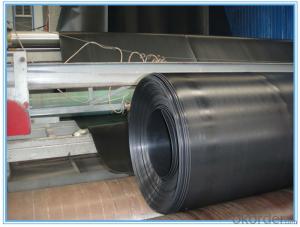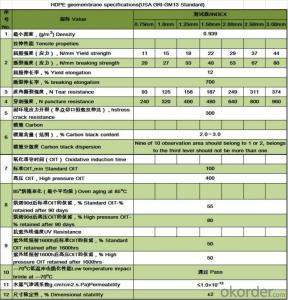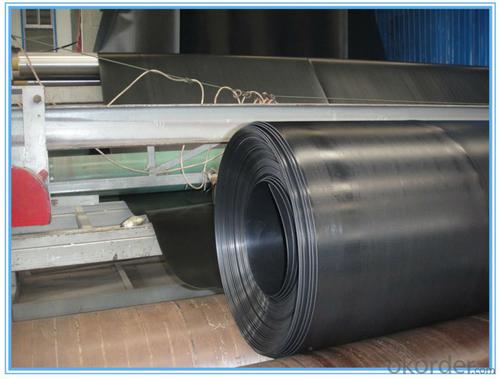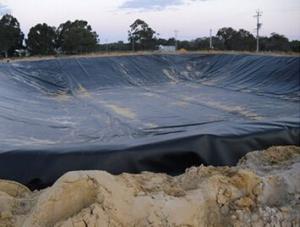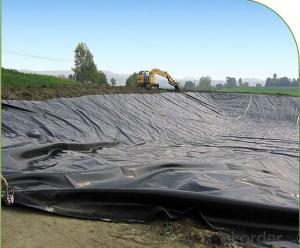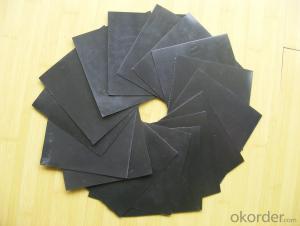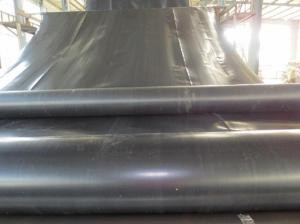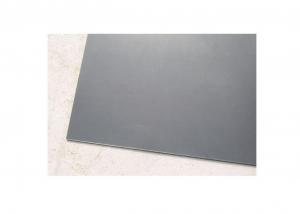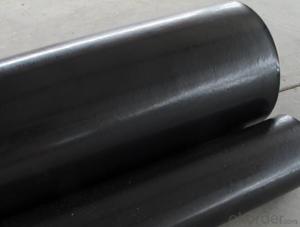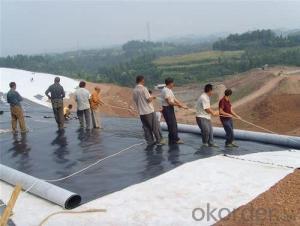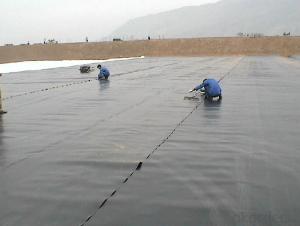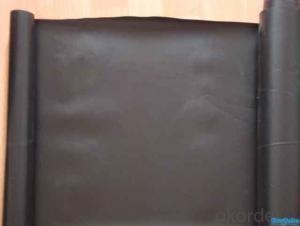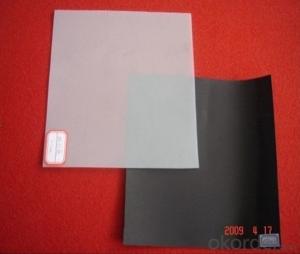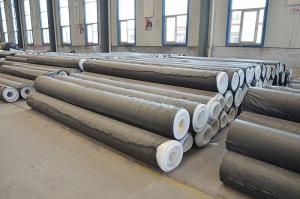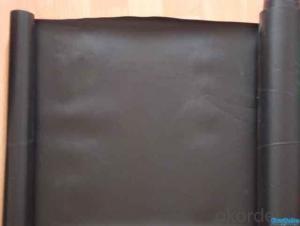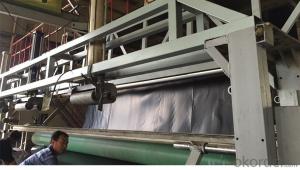FPP Aquaculture HDPE Geomembrane
- Loading Port:
- China Main Port
- Payment Terms:
- TT or LC
- Min Order Qty:
- -
- Supply Capability:
- -
OKorder Service Pledge
OKorder Financial Service
You Might Also Like
1.Product Aplication:
1) Water (such as rivers, lakes and reservoirs of the anti-dam, plugging, reinforcement of the canal seepage, the vertical wall of the heart, slope protection, etc.).
2) Municipal Engineering (subway, on the ground floor of the building, planted roof, the roof garden of anti-seepage, sewage pipes lining, etc.).
3) Landscape (man-made lake, river, reservoir, golf courses reservoirs of the substrate, slope protection, green lawn of the waterproof moisture, etc.).
4), Petrochemical (chemical plants, oil refineries, gas storage tanks of the anti-chemical reaction tanks, sedimentation tanks of the lining, etc.)
And they are used in:
1.used in landfill caps
2. base liner applications under roads, railways,
3.secondary containment for above ground tank farms,
4.as well as within various other containment structures such as dams, canals, ponds, rivers and lakes
5.They are also used for waterproofing of buildings and other similar structures.
2.Product Characteristic
Our product was proved as good physical and mechanic performance, high tearing resistance, strong deformation adaptability, puncture,
aging, ultra-violet radiation, oil and salt, alkali and corrosion resistance, high and low temperature resistance, non-toxicity, long operational
life, good waterproof, drainage, anti-seepage and damp proof effects, complete width and thickness specifications, low cost and simple
construction.
3.Product Specifications:
1.thickness : 0.1--3.0mm,
2.Length: 50 m -100 m ; width: 1 m -8 m ( according to customer needs )
3.Elongation at break:700%
3.Material: HDPE.
4.Color: Black or as your required
4.Reference Picture
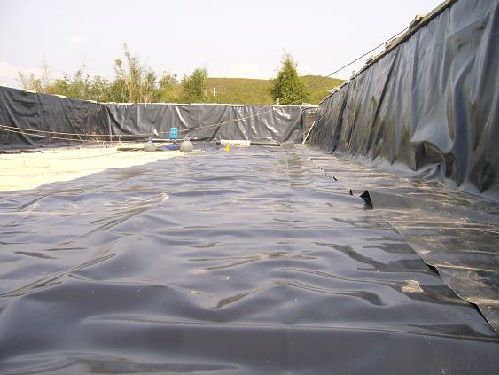
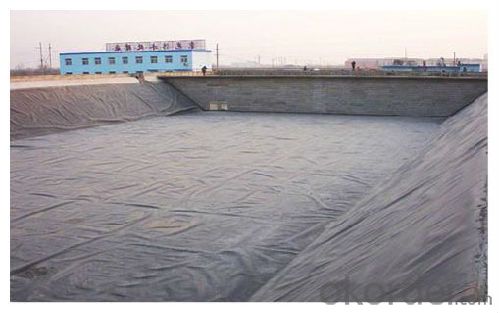
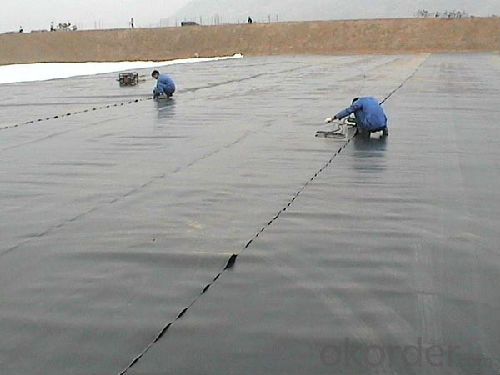
- Q: How do geomembranes contribute to oil and gas containment?
- Geomembranes contribute to oil and gas containment by providing a reliable barrier that prevents the leakage or seepage of oil and gas from storage tanks, pipelines, or containment pits. These specialized membranes, usually made of synthetic materials like high-density polyethylene (HDPE) or polyvinyl chloride (PVC), are highly resistant to corrosion, punctures, and chemical degradation. They effectively seal off the surrounding environment, preventing any potential pollution or contamination of soil, groundwater, or nearby water bodies. Geomembranes ensure the safe and secure containment of oil and gas, minimizing the risk of environmental damage and ensuring compliance with regulatory standards.
- Q: How to install the electrothermal?film non-woven fabrics?
- Installation steps of the electrothermal?film non-woven fabrics? Ground leveling first; the first layer: Extruded sheets should be paved on the top of the ground leveling layer; the second layer: Pave floor heating special thermal insulation reflective film; the third layer: Pave electrothermal?film imported from South Korea ; the fourth and fifth layer: Pave two-layer waterproof cloth or non-woven fabric; the sixth layer: Cement pressure plates or a protective plates are paved in the interlayer of the waterproof layers so as to protect electrothermal?film; the seventh layer: Drill 2 to 3 cm cement layer; the eighth layer: Pave floor tile or floor.
- Q: How do geomembranes perform in high wind conditions?
- Geomembranes are designed to perform well in high wind conditions. They are typically made from durable and flexible materials that can withstand strong winds without tearing or becoming damaged. Additionally, installation techniques such as anchoring and proper tensioning can further enhance their performance in high wind conditions.
- Q: Is the sunscreen film on the balcony useful?
- It is useful. The sunscreen film can reduce air conditioning costs by 30%. This year, in order to spend a cool summer, I stick the film in my house and it effectively insulate the house from heat. The outdoor temperature now is 35 degrees, and that in home is only 30 degrees, making the home very comfortable.
- Q: What are the installation requirements for geomembranes on slopes?
- The installation requirements for geomembranes on slopes typically include proper surface preparation, slope stabilization measures, anchoring systems, and appropriate overlap and welding techniques to ensure a secure and effective installation. It is also important to consider factors such as slope angle, soil conditions, and environmental considerations for successful geomembrane installation on slopes.
- Q: Geomembrane connection method
- Geomembrane connection method: hot melt welding.
- Q: What kinds can plastic film be devided into?
- It can be divided into many types according to different standards . General classification is based on the application of the sub, plastic film mainly used in the fields of: Food, medicine, chemical industry and other fields, among which the food packaging accounted for the largest proportion, for example, the beverage packaging, frozen food packaging, cooking food packaging, fast food packaging, these food is the fast moving consumer goods in our life, so the demand for plastic film is relatively large. Generally it can be divided into 7 kinds: Polyester film, nylon film, aluminium plating film, high resistance diaphragm, biaxially oriented polypropylene film, low density polyethylene film, cast polypropylene film.
- Q: Are geomembranes flexible or rigid?
- Geomembranes are typically flexible materials.
- Q: How do geomembranes contribute to dam construction?
- Geomembranes play a crucial role in dam construction by providing an impermeable barrier that prevents water from seeping through the dam structure. This helps in ensuring the stability and integrity of the dam, as it prevents the loss of water and potential leakage that could compromise its functionality. Additionally, geomembranes are used for lining reservoirs and canals, preventing seepage and protecting the environment from contamination. Overall, geomembranes enhance the efficiency and longevity of dam construction projects.
- Q: What are the advantages of using geomembranes in hydroelectric power generation projects?
- There are several advantages of using geomembranes in hydroelectric power generation projects. Firstly, geomembranes provide an effective barrier system that helps prevent water seepage and leakage, ensuring the integrity and stability of the water storage reservoirs and canals. This reduces the risk of water loss and potential damage to surrounding ecosystems. Secondly, geomembranes offer excellent chemical resistance, making them suitable for use in hydroelectric projects where the water may contain corrosive elements. This enhances the durability and longevity of the infrastructure. Furthermore, geomembranes are highly flexible and adaptable, allowing for easy installation on various types of terrain, including uneven or sloped surfaces. This flexibility ensures that the geomembranes can conform to the terrain and provide a secure lining system. Another advantage is that geomembranes are impermeable to gases, preventing the escape of harmful gases such as methane, which can be produced during the decomposition of organic matter in water reservoirs. This helps in maintaining a safe and environmentally friendly operation. Lastly, geomembranes have low maintenance requirements and are resistant to UV radiation, weathering, and biological degradation. This reduces the need for frequent repairs or replacements, resulting in cost savings over the long term. Overall, the use of geomembranes in hydroelectric power generation projects provides enhanced water containment, improved environmental protection, and reduced maintenance, making them a beneficial choice for such projects.
Send your message to us
FPP Aquaculture HDPE Geomembrane
- Loading Port:
- China Main Port
- Payment Terms:
- TT or LC
- Min Order Qty:
- -
- Supply Capability:
- -
OKorder Service Pledge
OKorder Financial Service
Similar products
Hot products
Hot Searches
Related keywords
